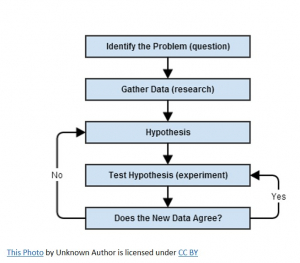You undoubtedly studied the scientific method in school. You may have even applied it to sophisticated experimentation. Think about how to use that approach for case evaluation and resolution now
 Scientific Method Going Through The Steps
The scientific method can be defined in as few as four steps or as many as ten, but let’s think about a five-step process.
First, identify the problem. Use what you know so far to start your action plan. For each possible issue, determine what information you need to resolve the question. That could be gathering records, talking to occurrence and expert witnesses, and researching alternative theories.
Second, gather data, i.e., discovery. The trick here is to be open to all information. Don’t ignore adverse information, a psychological phenomenon called confirmation bias. Your definition of the issues is likely to change as you collect more information.
Third, develop a hypothesis. This is your theory of the case. An amount of money or other relief is owed/not owed for the reasons shown by the data the parties have gathered.
Fourth, test your hypothesis. Here is where the art of case resolution and science diverge. Sometimes you can test your hypothesis with a motion to dismiss or for summary judgment. Those are rarely successful. This isn’t like subjecting a cell sample to different catalysts and seeing how it reacts.
The safest place to test your legal hypothesis is in mediation. Come prepared to experiment by seeing the result of your disclosures and negotiation. Besides interacting with your opponent in a structured, confidential process, you will get the benefit of the mediator’s guidance. Of course, unlike a scientific experiment, the best result, settlement, will probably fall somewhere between each side’s result hypothesis.
Without a settlement, parties must test their hypothesis by submitting the case to a judge or jury—and we all know how risky that can be.
Fifth, does the new data agree? What did you learn at the mediation? With this new information, you can revise your hypothesis and litigation strategy and test again. After a motion or trial, somebody won and somebody lost—at least theoretically. But a comparison of the net recovery or liability in comparison to the last offer and demand might show that neither side came out ahead. Depending on the posture of the case, it might not be too late to try to settle.
Use what you learned along this inquiry path to facilitate resolution in the next case.
How Thorough Do You Have To Be?
Scientists test every theory before they publish a paper of their results. The experimentation process can be long and expensive. Thankfully, you don’t have to go through that.
As soon as you get a file, you will start making decisions about how serious is this case. On the claimant side, the first decision is whether to accept the case, including what kind of time and money budget it will require. On the defense side, the client and counsel need to assess severity (is it a bet-the-company case/ is coverage available and adequate?) and possibly set reserves.
Even at the earliest stages, in most cases you have enough information to begin the negotiation and dispute resolution process. No, you don’t need to look under every rock for every crumb of information.
This claim may have started with a demand letter—a first opportunity for negotiation. Before litigation or before the parties undertake expensive discovery, consider convening a mediation.
Discovery will uncover facts which affect the evaluation of the case. After all, that is why you do it. Otherwise you are just spinning your wheels. Use that new information to suggest meeting with the mediator to conclude the case.
If that discovery leads parties to file potentially dispositive motions, the period while the motions are pending is another promising window for negotiation.
|






